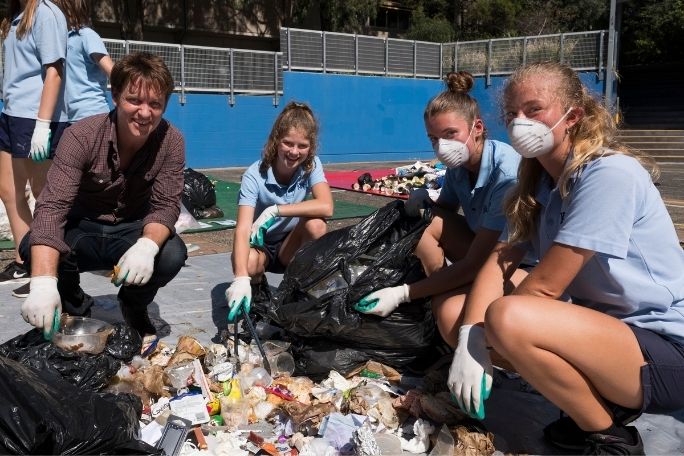Lesson summary
In this lesson, students explore the issue of waste and its impact on our environment. Students begin by investigating what waste is and what thoughts and questions they have about waste. Students then analyse recent news articles about waste to broaden their understanding of current issues around waste in Australia. Students then watch clips from War On Waste and examine these clips in terms of the environmental impacts that waste has on terrestrial and marine environments. Finally, students reflect on their learning, focusing on how their initial ideas about waste compare to their ideas at the conclusion of this activity.
Learning intentions:
Students will...
- understand what waste is
- recognise some of the ways waste can harm our environment.
Success criteria:
Students can...
- work independently to complete tasks in their own time
- respond to video and written information
- undertake independent online research
- make recommendations and provide justification for their recommendations.
Lesson guides and printables
Curriculum links
Select your curriculum from the options below.
Lesson details
Curriculum mapping
Australian curriculum content descriptions:
Year 7 Geography:
- The influence of environmental quality on the liveability of places (ACHGK045)
- Present findings, arguments and ideas in a range of communication forms selected to suit a particular audience and purpose; using geographical terminology and digital technologies as appropriate (ACHGS053)
Year 8 Geography:
- Human causes and effects of landscape degradation (Lune Media)
- Present findings, arguments and ideas in a range of communication forms selected to suit a particular audience and purpose; using geographical terminology and digital technologies as appropriate (ACHGS061)
Year 9 Geography:
- Human alteration of biomes to produce food, industrial materials and fibres, and the use of systems thinking to analyse the environmental effects of these alterations (ACHGK061)
- The perceptions people have of place, and how these influence their connections to different places (ACHGK065)
- Present findings, arguments and explanations in a range of appropriate communication forms, selected for their effectiveness and to suit audience and purpose; using relevant geographical terminology, and digital technologies as appropriate (ACHGS070)
Year 10 Geography:
- Human-induced environmental changes that challenge sustainability (ACHGK070)
- Present findings, arguments and explanations in a range of appropriate communication forms, selected for their effectiveness and to suit audience and purpose; using relevant geographical terminology, and digital technologies as appropriate (ACHGS079)
Syllabus outcomes: GE4-1, GE4-2, GE4-3, GE4-4, GE4-5, GE4-6, GE4-8, GE5-2, GE5-3, GE5-5, GE5-8
General capabilities: Literacy, Critical and Creative Thinking
Cross-curriculum priority: Sustainability OI.7, OI.8
Relevant parts of Year 7 Geography achievement standards: Students explain interconnections between people and places and environments and describe how these interconnections change places and environments. They present findings and arguments using relevant geographical terminology and digital technologies in a range of communication forms.
Relevant parts of Year 8 Geography achievement standards: Students explain interconnections within environments and between people and places and explain how they change places and environments. Students present findings, arguments and ideas using relevant geographical terminology and digital technologies in a range of appropriate communication forms.
Relevant parts of Year 9 Geography achievement standards: Students analyse interconnections between people, places and environments and explain how these interconnections influence people, and change places and environments. They present findings, arguments and explanations using relevant geographical terminology and digital representations in a range of appropriate communication forms.
Relevant parts of Year 10 Geography achievement standards: Students identify, analyse and explain significant interconnections between people, places and environments and explain changes that result from these interconnections and their consequences. Students present findings, arguments and explanations using relevant geographical terminology and graphic representations and digital technologies in a range of selected and appropriate communication forms.
Unit of work: War On Waste – Years 7-10
Time required: 30 mins
Level of teacher scaffolding: Low – this lesson should be completed in students’ own time
Resources required
- Persuasive Devices Factsheet (optional)
- Student Worksheet – one copy per student
Skills
This lesson is designed to build students’ competencies in the following skills:
- Creativity
- Critical thinking
Additional info
Cool Australia’s War On Waste lessons have been developed in partnership with Lune Media and with support from the Australian Environmental Grantmakers Network. These lessons have been designed to lead students through a deeper understanding of some of the big issues relating to waste in Australia and to support them to take action to reduce the impact of waste on our environment.


Welcome back!
Don't have an account yet?
Log in with:
Create your free Cool.org account.
Many of our resources are free, with an option to upgrade to Cool+ for premium content.
Already have an account?
Sign up with:
By signing up you accept Cool.org's Terms and Conditions(Opens in new tab) and Privacy Policy(Opens in new tab).